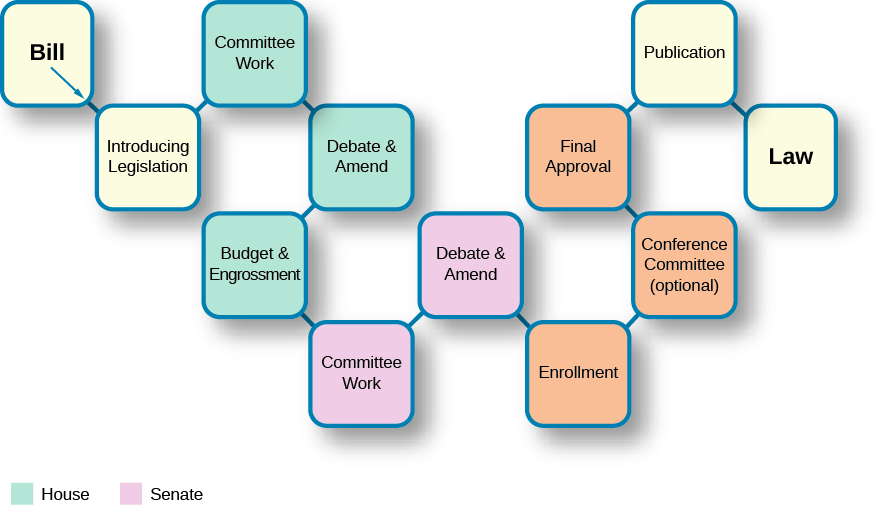| << Chapter < Page | Chapter >> Page > |

For one look at the classic legislative process, visit YouTube to view “I’m Just a Bill” from the ABC Schoolhouse Rock! series.
For much of the nation’s history, the process described above was the standard method by which a bill became a law. Over the course of the last three and a half decades, however, changes in rules and procedure have created a number of alternate routes. Collectively, these different routes constitute what some political scientists have described as a new but unorthodox legislative process. According to political scientist Barbara Sinclair, the primary trigger for the shift away from the classic legislative route was the budget reforms of the 1970s. The 1974 Budget and Impoundment Control Act gave Congress a mechanism for making large, all-encompassing, budget decisions. In the years that followed, the budget process gradually became the vehicle for creating comprehensive policy changes. One large step in this transformation occurred in 1981 when President Ronald Reagan’s administration suggested using the budget to push through his economic reforms.
The benefit of attaching the reforms to the budget resolution was that Congress could force an up or down (yea or nay) vote on the whole package. Such a packaged bill is called an
omnibus bill .
An important characteristic feature of modern legislating is the greatly expanded power and influence of the party leadership over the control of bills. One reason for this change was the heightened partisanship that stretches back to the 1980s and is still with us today. With such high political stakes, the party leadership is reluctant to simply allow the committees to work things out on their own. In the House, the leadership uses special rules to guide bills through the legislative process and toward a particular outcome. Uncommon just a few decades ago, these now widely used rules restrict debate and options, and are designed to focus the attention of members.
The practice of multiple referrals, with which entire bills or portions of those bills are referred to more than one committee, greatly weakened the different specialization monopolies committees held primarily in the House but also to an extent in the Senate. With less control over the bills, committees naturally reached out to the leadership for assistance. Indeed, as a testament to its increasing control, the leadership may sometimes avoid committees altogether, preferring to work things out on the floor. And even when bills move through the committees, the leadership often seeks to adjust the legislation before it reaches the floor.
Another feature of the modern legislative process, exclusively in the Senate, is the application of the modern filibuster. Unlike the traditional filibuster, in which a senator took the floor and held it for as long as possible, the modern filibuster is actually a perversion of the cloture rules adopted to control the filibuster. When partisanship is high, as it has been frequently, the senators can request cloture before any bill can get a vote. This has the effect of increasing the number of votes needed for a bill to advance from a simple majority of fifty-one to a super majority of sixty. The effect is to give the Senate minority great power to obstruct if it is inclined to do so.
The Library of Congress’s Thomas website has provided scholars, citizens, and media with a bounty of readily available data on members and bills for more than two decades.
In the classic legislative process, bills are introduced and sent to the appropriate committee. Within the committees, hearings are held and the bill is debated and ultimately sent to the floor of the chamber. On the floor, the bill is debated and amended until passed or voted down. If passed, it moves to the second chamber where the debating and amending begins anew. Eventually, if the bill makes it that far, the two chambers meet in a joint committee to reconcile what are now two different bills. Over the last few decades, however, Congress has adopted a very different process whereby large pieces of legislation covering many different items are passed through the budgeting process. This method has had the effect of further empowering the leadership, to the detriment of the committees. The modern legislative process has also been affected by the increasing number of filibuster threats in the Senate and the use of cloture to forestall them.
Books:
Binder, Sarah A. 1997. Minority Rights, Majority Rule: Partisanship and the Development of Congress . Cambridge, UK: Cambridge University Press.
Davidson, Roger H. and Walter J. Oleszek. 1981. Congress and Its Members . Washington, DC: Congressional Quarterly Press.
Dodd, Lawrence C. and Bruce Ian Oppenheimer. 1981. Congress Reconsidered . Washington, DC: Congressional Quarterly Press.
Hofstadter, Richard. 1965. The Paranoid Style in American Politics, and Other Essays . New York: Knopf.
Mann, Thomas E. and Norman J. Ornstein. 2012. It’s Even Worse Than It Looks: How the American Constitutional System Collided with the New Politics of Extremism . New York: Basic Books.
Mayhew, David R. 1974. Congress: The Electoral Connection . New Haven, CT: Yale University Press.
Mutch, Robert E. 2014. Buying the Vote: A History of Campaign Finance Reform . Oxford: Oxford University Press.
Oleszek, Walter J. 1978. Congressional Procedures and the Policy Process . Washington: Congressional Quarterly Press.
Sinclair, Barbara. 1997. Unorthodox Lawmaking: New Legislative Processes in the U.S. Congress . Washington, DC: CQ Press.
Films:
1939. Mr. Smith Goes to Washington .
1957. A Face in the Crowd.
1962. Advise and Consent .
1972. The Candidate .

Notification Switch
Would you like to follow the 'American government' conversation and receive update notifications?